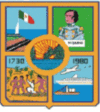Cabo San Lucas, Mexico
|
Cabo San Lucas Yenecami |
||
|---|---|---|

View of the harbor Cabo San Lucas (2005)
|
||
|
||
| Nickname(s): Cabo | ||
| Location in Baja California Sur | ||
| Coordinates: 22°53′23″N 109°54′56″W / 22.88972°N 109.91556°WCoordinates: 22°53′23″N 109°54′56″W / 22.88972°N 109.91556°W | ||
| Country |
|
|
| State | Baja California Sur | |
| Elevation | 20 m (70 ft) | |
| Population (2010) | ||
| • Total | 68,463 | |
| Time zone | MST (UTC−7) | |
| • Summer (DST) | MDT (UTC−6) | |
Cabo San Lucas (Spanish pronunciation: [ˈkaβo san ˈlukas], Cape Saint Luke), commonly called Cabo in American English, is a city at the southern tip of the Baja California Peninsula, in the Mexican state of Baja California Sur. Cabo San Lucas together with San José del Cabo is known as Los Cabos.
Cabo has been rated as one of Mexico's top 5 tourist destinations; it is known for its beaches, scuba diving locations, balnearios, the sea arch El Arco de Cabo San Lucas, and marine life. The Los Cabos Corridor has become a heavily trafficked holiday destination for tourists, with numerous resorts and timeshares along the coast between Cabo San Lucas and San José del Cabo.
Cabo houses a range of wildlife, including rays, sharks, birds, and a range of fish, such as mahi-mahi (dorado), and striped marlin.
Archaeological excavations have shown evidence of continual human habitation in the area for at least 10,000 years. When the first Europeans arrived, they encountered the Pericú people, who survived on a subsistence diet based on hunting and gathering seeds, roots, shellfish, and other marine resources. They called the location Yenecamú.
...
Wikipedia


